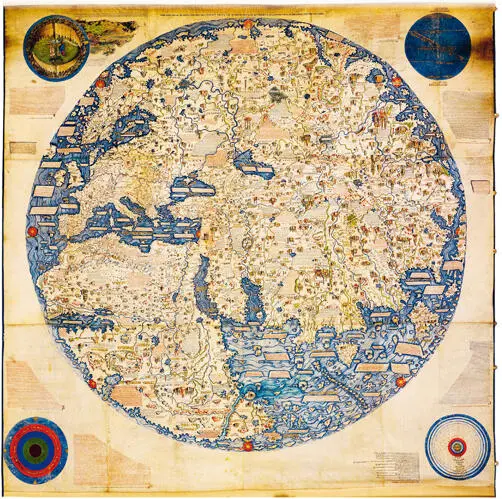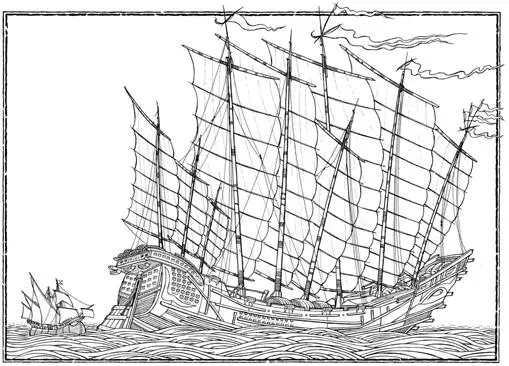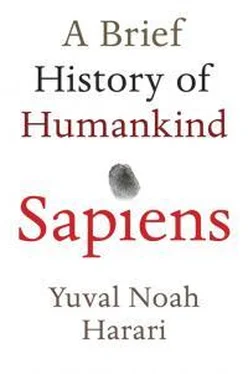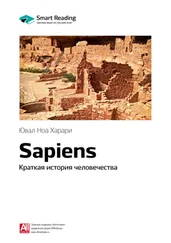
36. A European world map from 1459 (Europe is in the top left corner). The map is filled with details, even when depicting areas that were completely unfamiliar to Europeans, such as southern Africa.
The first modern man was Amerigo Vespucci, an Italian sailor who took part in several expeditions to America in the years 1499–1504. Between 1502 and 1504, two texts describing these expeditions were published in Europe. They were attributed to Vespucci. These texts argued that the new lands discovered by Columbus were not islands off the East Asian coast, but rather an entire continent unknown to the Scriptures, classical geographers and contemporary Europeans. In 1507, convinced by these arguments, a respected mapmaker named Martin Waldseemüller published an updated world map, the first to show the place where Europe’s westward-sailing fleets had landed as a separate continent. Having drawn it, Waldseemüller had to give it a name. Erroneously believing that Amerigo Vespucci had been the person who discovered it, Waldseemüller named the continent in his honour – America. The Waldseemüller map became very popular and was copied by many other cartographers, spreading the name he had given the new land. There is poetic justice in the fact that a quarter of the world, and two of its seven continents, are named after a little-known Italian whose sole claim to fame is that he had the courage to say, ‘We don’t know.’
The discovery of America was the foundational event of the Scientific Revolution. It not only taught Europeans to favour present observations over past traditions, but the desire to conquer America also obliged Europeans to search for new knowledge at breakneck speed. If they really wanted to control the vast new territories, they had to gather enormous amounts of new data about the geography, climate, flora, fauna, languages, cultures and history of the new continent. Christian Scriptures, old geography books and ancient oral traditions were of little help.
Henceforth not only European geographers, but European scholars in almost all other fields of knowledge began to draw maps with spaces left to fill in. They began to admit that their theories were not perfect and that there were important things that they did not know.
The Europeans were drawn to the blank spots on the map as if they were magnets, and promptly started filling them in. During the fifteenth and sixteenth centuries, European expeditions circumnavigated Africa, explored America, crossed the Pacific and Indian Oceans, and created a network of bases and colonies all over the world. They established the first truly global empires and knitted together the first global trade network. The European imperial expeditions transformed the history of the world: from being a series of histories of isolated peoples and cultures, it became the history of a single integrated human society.

37. The Salviati World Map, 1525. While the 1459 world map is full of continents, islands and detailed explanations, the Salviati map is mostly empty. The eye wanders south along the American coastline, until it peters into emptiness. Anyone looking at the map and possessing even minimal curiosity is tempted to ask, ‘What’s beyond this point?’ The map gives no answers. It invites the observer to set sail and find out.
These European explore-and-conquer expeditions are so familiar to us that we tend to overlook just how extraordinary they were. Nothing like them had ever happened before. Long-distance campaigns of conquest are not a natural undertaking. Throughout history most human societies were so busy with local conflicts and neighbourhood quarrels that they never considered exploring and conquering distant lands. Most great empires extended their control only over their immediate neighbourhood – they reached far-flung lands simply because their neighbourhood kept expanding. Thus the Romans conquered Etruria in order to defend Rome ( c .350–300 BC). They then conquered the Po Valley in order to defend Etruria ( c .200 BC). They subsequently conquered Provence to defend the Po Valley ( c .120 BC), Gaul to defend Provence ( c .50 BC), and Britain in order to defend Gaul ( c . AD 50). It took them 400 years to get from Rome to London. In 350 BC, no Roman would have conceived of sailing directly to Britain and conquering it.
Occasionally an ambitious ruler or adventurer would embark on a long-range campaign of conquest, but such campaigns usually followed well-beaten imperial or commercial paths. The campaigns of Alexander the Great, for example, did not result in the establishment of a new empire, but rather in the usurpation of an existing empire – that of the Persians. The closest precedents to the modern European empires were the ancient naval empires of Athens and Carthage, and the medieval naval empire of Majapahit, which held sway over much of Indonesia in the fourteenth century. Yet even these empires rarely ventured into unknown seas – their naval exploits were local undertakings when compared to the global ventures of the modern Europeans.
Many scholars argue that the voyages of Admiral Zheng He of the Chinese Ming dynasty heralded and eclipsed the European voyages of discovery. Between 1405 and 1433, Zheng led seven huge armadas from China to the far reaches of the Indian Ocean. The largest of these comprised almost 300 ships and carried close to 30,000 people. 7They visited Indonesia, Sri Lanka, India, the Persian Gulf, the Red Sea and East Africa. Chinese ships anchored in Jedda, the main harbour of the Hejaz, and in Malindi, on the Kenyan coast. Columbus’ fleet of 1492 – which consisted of three small ships manned by 120 sailors – was like a trio of mosquitoes compared to Zheng He’s drove of dragons. 8
Yet there was a crucial difference. Zheng He explored the oceans, and assisted pro-Chinese rulers, but he did not try to conquer or colonise the countries he visited. Moreover, the expeditions of Zheng He were not deeply rooted in Chinese politics and culture. When the ruling faction in Beijing changed during the 1430s, the new overlords abruptly terminated the operation. The great fleet was dismantled, crucial technical and geographical knowledge was lost, and no explorer of such stature and means ever set out again from a Chinese port. Chinese rulers in the coming centuries, like most Chinese rulers in previous centuries, restricted their interests and ambitions to the Middle Kingdom’s immediate environs.
The Zheng He expeditions prove that Europe did not enjoy an outstanding technological edge. What made Europeans exceptional was their unparalleled and insatiable ambition to explore and conquer. Although they might have had the ability, the Romans never attempted to conquer India or Scandinavia, the Persians never attempted to conquer Madagascar or Spain, and the Chinese never attempted to conquer Indonesia or Africa. Most Chinese rulers left even nearby Japan to its own devices. There was nothing peculiar about that. The oddity is that early modern Europeans caught a fever that drove them to sail to distant and completely unknown lands full of alien cultures, take one step on to their beaches, and immediately declare, ‘I claim all these territories for my king!’

38. Zheng He’s flagship next to that of Columbus.
Читать дальше






![Юваль Ной Харари - Sapiens. Краткая история человечества [litres]](/books/34310/yuval-noj-harari-sapiens-kratkaya-istoriya-cheloveche-thumb.webp)





![Юваль Ной Харари - 21 урок для XXI века [Версия с комментированными отличиями перевода]](/books/412481/yuval-noj-harari-21-urok-dlya-xxi-veka-versiya-s-ko-thumb.webp)


